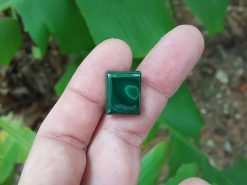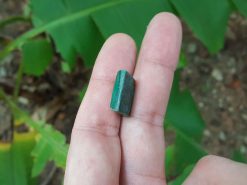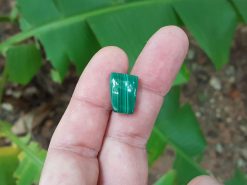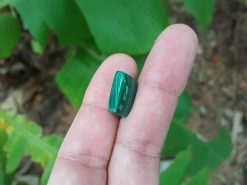Malachite
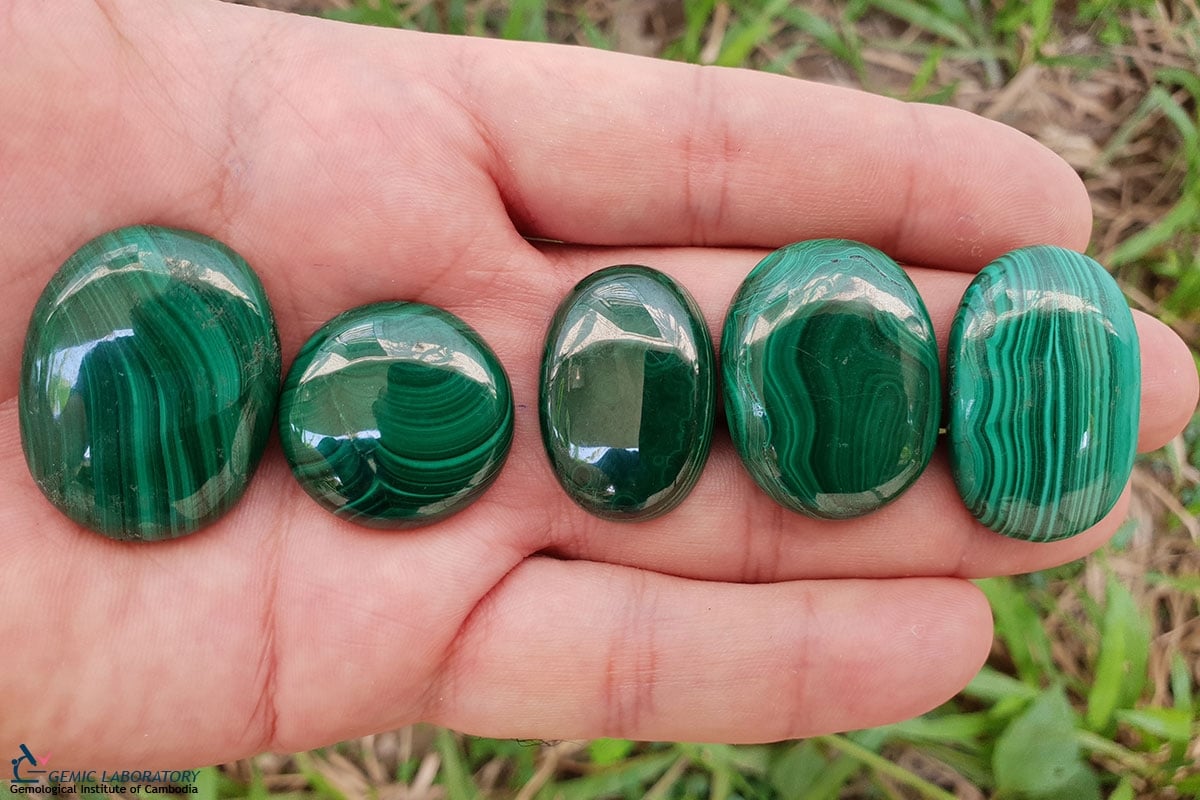
Malachite is a green stone composed of copper carbonate hydroxide, forming an opaque mineral known for its stunning bands of light and dark green layers. Prized throughout history for its vibrant color and ornamental uses, this gem draws attention for both its striking appearance and its energetic qualities.
Buy natural malachite in our shop
Malachite meaning
This copper carbonate hydroxide mineral, with the formula Cu2CO3(OH)2, often displays prominent bands in varying shades of green. These bands are typically formed in concentric rings, giving many polished specimens their distinct “eye-like” appearance. The stone crystallizes in the monoclinic crystal system, frequently appearing in botryoidal (grape-like) or fibrous masses deep underground where hydrothermal fluids and water provide the ideal conditions for chemical precipitation.
While crystals of this green mineral are relatively rare, they can sometimes manifest as slender, acicular prisms. The mineral can also form pseudomorphs after blocky azurite crystals, replacing them over time but retaining their original shape. This transformative nature highlights malachite’s ever-evolving character in the earth’s geological processes.
History
Evidence shows that the oldest mining sites for this lush green stone are located at Great Orme in Great Britain, dating back some 3,800 years. Early miners worked with rudimentary stone and bone tools to extract copper from the ore. Significant operations in this area appear to have concluded around 600 B.C.E., producing an estimated 1,760 tonnes of copper.
In the Timna Valley of Israel, archaeological finds suggest that malachite was mined and smelted for over 3,000 years, reflecting its long-standing value as a copper source. Beyond its practical applications for metal production, this gemstone has also been treasured through the ages as a captivating ornamental stone. In ancient Egypt, the color green was closely linked to fertility, rebirth, and the power of resurrection. Believers envisioned an eternal paradise in the afterlife, referring to it as the “Field of Malachite” due to the color’s symbolic link with growth and renewal.
Throughout various civilizations, malachite was carved into amulets, jewelry, decorative columns, and architectural details. Its use as a pigment in artistic works was also common, owing to the mineral’s strong green hue. Today, museums and historical collections worldwide often feature intricately crafted artifacts that showcase malachite’s enduring cultural significance.
Malachite gemological properties
This lush, green stone typically emerges from the weathering of copper ores. It is commonly discovered alongside azurite (Cu3(CO3)2(OH)2), goethite, and calcite. Although malachite’s properties resemble those of azurite, its hallmark is the vibrant green color that has made it famous. Aggregates containing both malachite and azurite are frequently found in copper-rich deposits, especially near or within limestone host rock, which supplies the necessary carbonate component.
The mineral rates between 3.5 and 4 on the Mohs hardness scale, making it a relatively soft stone that requires gentle handling. Despite its softness, malachite can be polished to a high luster, revealing the signature banding that continues to captivate gem enthusiasts and collectors alike.
Mines location
Historically, large deposits were unearthed in the Ural Mountains of Russia. Although those famed Ural deposits are no longer actively mined, there have been reports of potential new discoveries in the region. Notably, this green gemstone occurs worldwide, with significant sources in the Democratic Republic of Congo, Gabon, Zambia, Namibia (Tsumeb), Mexico, France (Lyon), and Israel (Timna Valley). In the United States, malachite has been discovered in several southwestern states, particularly Arizona, which is known for its copper deposits.
These varied geographic origins ensure that malachite remains accessible for use in jewelry, decorative items, and mineral collections. Each locale can produce slightly different patterns, intensities of green, and banding structures, further adding to the stone’s unique appeal.
Malachite green crystal meaning and properties
The following section is pseudo-scientific and based on cultural beliefs.
Many crystal enthusiasts regard malachite as an absorber of negative energies, believing it draws impurities from both the surrounding environment and the body. Its reputation as a guardian against radiation and electromagnetic pollution has made it popular among practitioners of alternative wellness.
Metaphysically, it’s often considered a stone that encourages personal transformation and spiritual guidance. Believers hold that it can open the heart chakra, unlocking the capacity for unconditional love, personal growth, and healing.
FAQ
What is the spiritual meaning of malachite?
Malachite green crystal meaning and properties. A stone of balance, abundance, manifestation, and intention. Often called the stone of transformation, it is used for energy cleansing and positive change.
Is malachite toxic to humans?
There is no harm in wearing malachite as jewelry, but you should never ingest it. Like many minerals containing copper, malachite dust can be toxic if inhaled or ingested. Always wash your hands after handling unsealed or rough specimens.
Can you wear malachite everyday?
Yes, but be mindful it is a relatively soft stone. Many people find that wearing it daily at or near the heart chakra helps balance their emotions and energies. If you are drawn to it without a specific intention, wearing it near the heart may be most beneficial.
Where should I put malachite in my house?
Some believe placing it in the eastern part of a home encourages health and family harmony, while placing it in the southeast invites prosperity. Because it symbolizes transformation and growth, malachite can be kept in any room undergoing a new project or recent renovation to help foster positive change.
What’s malachite good for?
It is regarded as a strong protection stone, absorbing negativity from surroundings and from the body. It is also thought to guard against electromagnetic pollution and to cleanse and activate chakras, aligning one with higher spiritual guidance.
Is malachite good luck?
Many people see it as a stone of good fortune, abundance, and prosperity. By converting energies of lack into abundance, it can facilitate productive work and attract success, helping to boost self-confidence.
How do you handle malachite?
Because malachite can release harmful dust when fractured or ground, you should avoid inhaling or ingesting any particles. After handling dusty specimens, simply wash your hands thoroughly. Polished and sealed forms are typically safe to handle.
Which chakra is malachite good for?
Malachite is often associated with the heart chakra, believed to encourage emotional healing, forgiveness, and self-love. Its energetic resonance with this chakra may help with overall emotional well-being.
How can you tell if malachite is real?
Genuine malachite feels cool to the touch, has substantial weight for its size, and displays natural variations in its banding and color. Look for circular or wavy patterns and a range from dark to light green. Artificial or imitation pieces may appear too uniform or lack the natural pattern details.
Is malachite a lucky stone?
Malachite is frequently considered one of the luckiest stones, renowned for its ability to heal deep-seated emotional issues and encourage personal growth. As a heart-centered stone, it may inspire facing and releasing traumas from the past.
How do you cleanse and charge malachite?
Because malachite can absorb negative energy, it may need regular cleansing. Popular methods include placing it on a quartz cluster or inside a geode. Some practitioners suggest sunlight or returning it to the earth, but always protect the stone from harsh elements due to its relative softness.
Why is malachite so expensive?
Its distinct banding and “peacock’s eye” patterns greatly influence value. The more pronounced and numerous the rings, the higher the perceived worth. Larger specimens reveal more intricate patterns, making them especially sought after. Malachite jewelry—such as bracelets, necklaces, and pendants—is also in high demand for its dramatic appearance.
Can you wear malachite in the shower?
Although pure water typically does not harm this mineral, shower products containing chemicals can damage its luster or cause discoloration. If you choose to shower with malachite, rinse it gently afterward. Cleaning the stone occasionally with a soft, damp cloth can help preserve its shine.
Where are green malachite crystal found?
This copper-based mineral is found globally, with notable sources in the Congo, Gabon, Zambia, Namibia, Mexico, and Australia. Historically, the largest mine is located in the Urals region of Russia.
Natural malachite for sale in our gem shop
We specialize in crafting custom malachite jewelry, including engagement rings, necklaces, earrings, bracelets, and pendants. Each piece showcases the stone’s distinct banding and lively hue. To begin your own unique design project, please contact us for a quote or more information.

